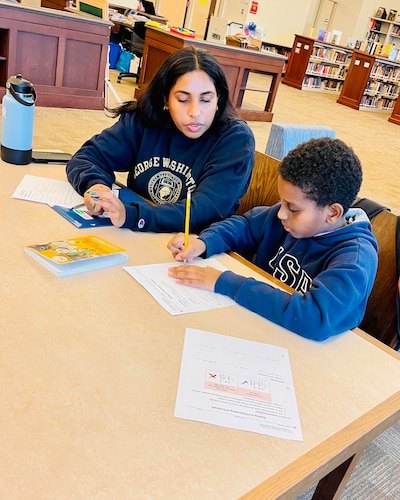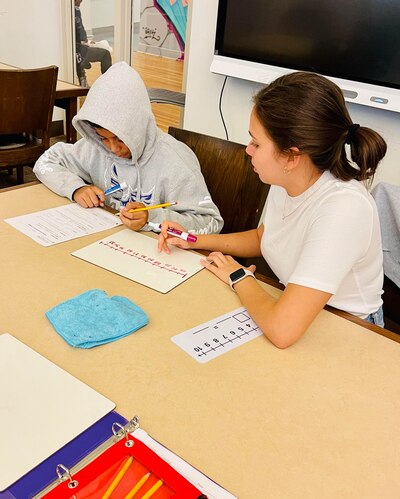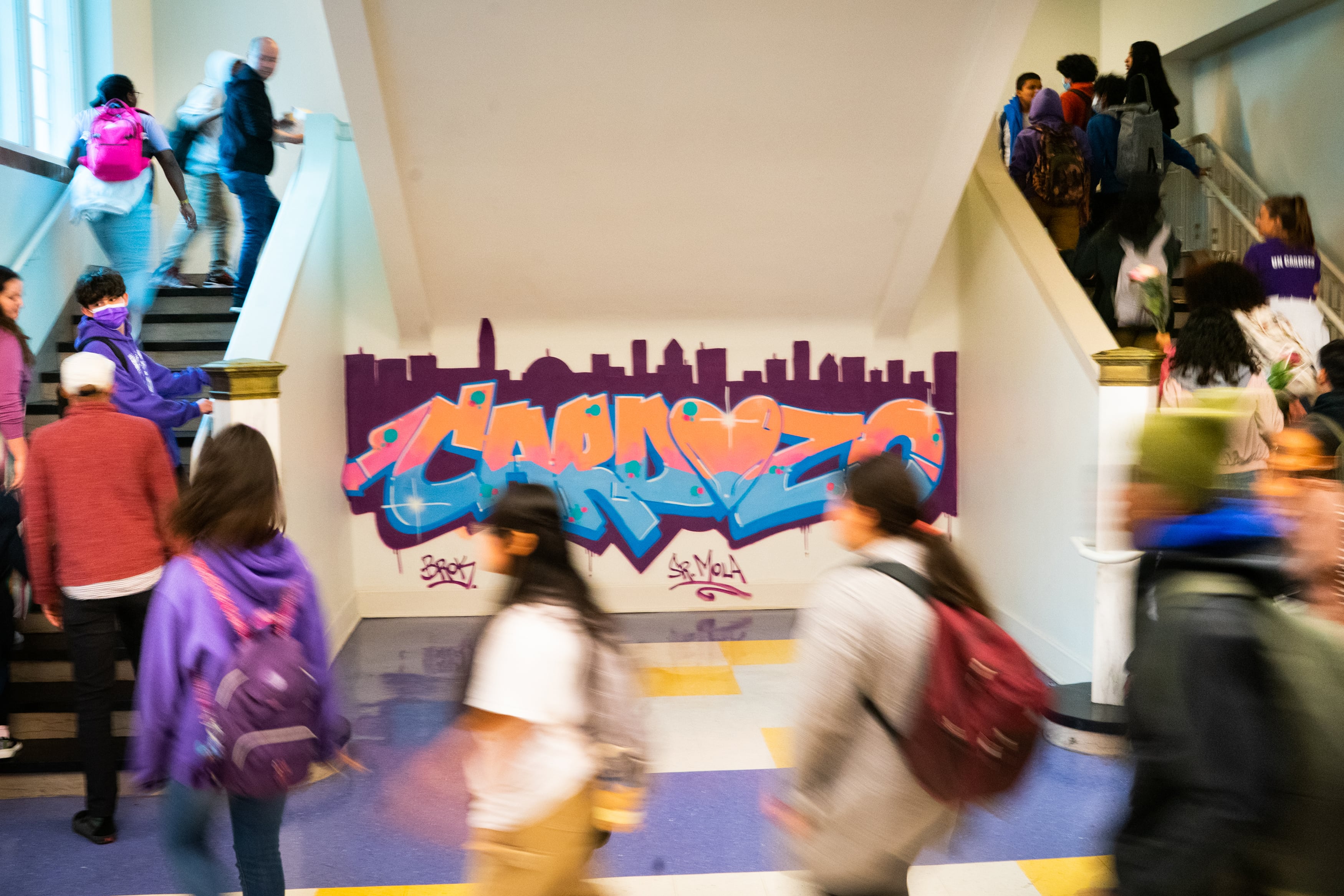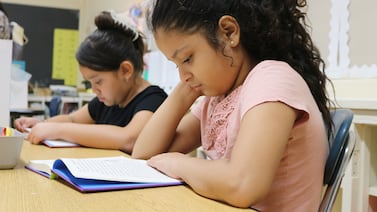Sign up for Chalkbeat’s free weekly newsletter to keep up with how education is changing across the U.S.
Twelve-year-old Ethen likes spending time with his math tutors — and not always for reasons related to math.
They crack jokes and play chess with him when he finishes his work early. He likes meeting with them in the library, where it’s easier to ask questions without being talked over. And when he’s had a rough day, he can count on his tutors to cheer him up.
“That’s something good for me because I get to finally see someone that’s happy to see me,” said Ethen, a sixth grader at Cardozo Education Campus in Washington, D.C. “Their smile makes me smile.”
Lots of research has shown that intensive tutoring is one of the best ways to help students improve academically. And it’s become a go-to strategy to help kids who missed a lot of instruction during the pandemic. But a new study suggests high-dosage tutoring can boost something else, too: attendance.
Preliminary research recently released by Stanford University’s National Student Support Accelerator, which is conducting various tutoring studies, found that D.C. students who participated in an intensive tutoring program were more likely to show up to school on days they had a scheduled session. Overall, the likelihood they’d miss school on tutoring days fell by 7%, researchers found.
That finding is especially significant because many schools are still working to re-engage students and curb higher-than-usual absenteeism rates in the wake of the pandemic.
The study doesn’t answer why tutoring boosted attendance. One reason could be that many students, like Ethen, really like their tutors, who often serve as informal mentors and sometimes bond with students outside the classroom, too.
“The kids do feel really cared for,” said Christine Maffuccio, who oversees the high-impact tutoring program at Cardozo. She said that’s because tutors are at students’ side asking: “What do you need? What’s your first step?”
Another reason could be that, after the isolation of remote learning, tutoring reinforces the idea that “learning happens in the classroom, together.”
“As we’re kind of re-teaching kids how to be in school and why they should be engaged in class,” Maffuccio said, “I think the tutor’s presence in the class helps with that.”
The link between tutoring and attendance
Tutors are everywhere at Cardozo. On any given day, 25 tutors are working with students at the combined middle and high school. Many are college students or AmeriCorps members.
Now, many students don’t think twice about getting extra help because it’s become so common. Earlier this school year, 330 students were getting tutored at Cardozo — almost half of all students.

The work happening at Cardozo is part of a three-year, $33 million initiative run by D.C.’s Office of the State Superintendent of Education with the help of federal COVID relief funding. To receive grant funding, schools agreed to follow certain tutoring best practices, such as keeping tutoring groups small, regularly pairing students with the same tutor, and offering at least 90 minutes a week of intensive help. (A rigorous study of the program’s academic effects is ongoing, but officials say there’s been promising early evidence that the high-dosage tutoring has helped struggling students improve in math and reading.)
As part of that initiative, Stanford researchers looked at attendance records for nearly 4,500 students who received intensive math or reading tutoring during the 2022-23 school year. That included students from Cardozo and 141 other D.C. schools.
The better attendance on tutoring days added up to students getting, on average, an extra two days of instruction over the course of the school year — and as much as five days if the student had been absent a lot.
The effect was most pronounced for middle schoolers, whose likelihood of attending school rose by 11% on days they had a scheduled tutoring session.
The research didn’t look at what exactly made students want to come to school more. But researchers and school staff have some ideas, based on feedback they’ve collected from students and what they’ve observed.
They think the consistency and frequency with which students met with their tutors was likely important. Many students liked the more-personalized attention and wanted to spend time with their tutors. Others wanted to come to school more when they did better academically.
“That individual relationship that they’re building in that tutoring session seems like it could be one of those things” boosting engagement, said Nancy Waymack, who directs research partnerships for the National Student Support Accelerator. “If tutoring is having a positive academic effect on that student, they’re also more likely to be able to be successful in their day-to-day schoolwork, which would also make it more attractive to be at school.”
At Cardozo, Maffuccio has seen that students who may feel intimidated by the idea of asking their teacher for help will feel comfortable turning to a tutor, who may seem more like a big brother or an auntie.
“Students’ personalities come out a lot because not every sentence that they speak with their tutor has to be on task,” Maffuccio said. “I see joking and just kind of talking about their lives. That’s really an important part of the relationship-building — that’s how the space becomes safe for students to try and potentially fail.”
Some tutors end up connecting with students outside of class, too. One tutor who works with ninth graders in their English language arts class, for example, now coaches Cardozo’s middle school soccer team and has close relationships with lots of the players.
Tutors start from ‘a really upbeat, positive place’
Isabelle Jennings Pickering started tutoring at Cardozo in October. Jennings Pickering, known to students as Miss J, works mostly with ninth and 12th graders in their history classes, and she also helps students with their English and reading fluency.
As she gets to know a student, she starts by asking them personal questions — Do they play sports? What music are they listening to? — before diving into the academic material.

Last semester, for example, when she started working with 17-year-old Miguel several times a week in his D.C. history class, she noticed that he loved talking about music and culture, but it was harder to talk about what was tripping him up in class.
So they “started from a really upbeat, positive place,” by chatting in Spanish and trading notes about their favorite Salvadoran foods. After that, it was easier to talk about academic “concerns and fears and sticky places,” Jennings Pickering said.
Speaking English can be scary for Miguel and many other students whose first language isn’t English, Jennings Pickering said. So she tries to make the tutoring session a safe place where students won’t shut down if she gently corrects their pronunciation.
“It’s often the thought that school isn’t for me, and reading isn’t for me, or English isn’t for me,” she said. “And fighting through that can be the biggest hurdle.”
When she’s able to help students see that learning just one new word or sentence is a success, “that’s huge,” she said.
Since he started working with a tutor, Miguel says he feels more comfortable in class and he’s getting his assignments done faster, too. And he’s proud he can now use the transitional words that Miss J taught him in his essays.
Among his go-tos?
“Therefore” and “however.”
Kalyn Belsha is a senior national education reporter based in Chicago. Contact her at kbelsha@chalkbeat.org.







